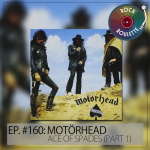
Episode 160 of Rock Roulette has arrived! This time the wheel sent us straight into the fast lane with Motörhead’s legendary Ace of Spades!
A record built on speed, grit, and raw rock ’n’ roll power. Crank it loud and ride with us through this classic!
Ace of Spades is the fourth studio album by English rock band Motörhead, released in October 1980 via Bronze Records. It is the band’s most commercially successful album, peaking at number four on the UK Albums Chart and reaching gold status in the UK by March 1981. It was preceded by the release of the title track as a single in October, which peaked in the UK Singles Chart at No. 15 in early November.
It was the band’s debut release in the United States, with Mercury Records handling distribution in North America. In 2020, the album was ranked at 408 on Rolling Stone’s 500 Greatest Albums of All-Time list.
By 1979, Motörhead had released two extremely successful classic albums, Overkill and Bomber, and had gained a loyal fan following by constant touring and television appearances. Their ferocious, loud proto-thrash playing style appealed equally to punks and heavy metal fans, but in 1979 Sounds writer Geoff Barton coined the term “New Wave of British Heavy Metal” (NWOBHM) to classify a slew of newer bands such as Iron Maiden, Def Leppard, and Saxon. Motörhead – a band that resented being labeled anything other than rock ‘n’ roll – was placed in this new genre, which would go on to influence the emerging thrash metal movement that would include bands like Metallica and Megadeth.
Motörhead
Lemmy – vocals, bass, backing vocals on “Emergency”
“Fast” Eddie Clarke – lead guitar, lead vocals on “Emergency”
Phil “Philthy Animal” Taylor – drums
Production
Vic “Chairman” Maile – producer, engineer & mixing
Giovanni Scatola – mastering (2005 remaster)
Layout
Martin Poole – design
Alan Ballard – photography
Curt Evans – 2005 cover design
Joe Petagno – Snaggletooth
Intro Music/Wheel Spin Music by LiteSaturation from Pixabay

Fair Use
* Copyright Disclaimer Under Section 107 of the Copyright Act 1976, allowance is made for "fair use" for purposes such as criticism, comment, news reporting, teaching, scholarship, and research. Fair use is a use permitted by copyright statute that might otherwise be infringing. Non-profit, educational, or personal use tips the balance in favor of fair use. No copyright infringement intended. ALL RIGHTS BELONG TO THEIR RESPECTIVE OWNERS
This is our musical reaction, breakdown, and commentary analysis of the song. We intend no copyright infringement, and this is not a replacement for listening to the artist's music. The content made available through this site is for educational and informational purposes only.
The site may contain copyrighted material owned by a third party, the use of which has not always been specifically authorized by the copyright owner. Notwithstanding a copyright owner’s rights under the Copyright Act, Section 107 of the Copyright Act allows limited use of copyrighted material without requiring permission from the rights holders, for purposes such as education, criticism, comment, news reporting, teaching, scholarship, and research. These so-called “fair uses” are permitted even if the use of the work would otherwise be infringing. *





